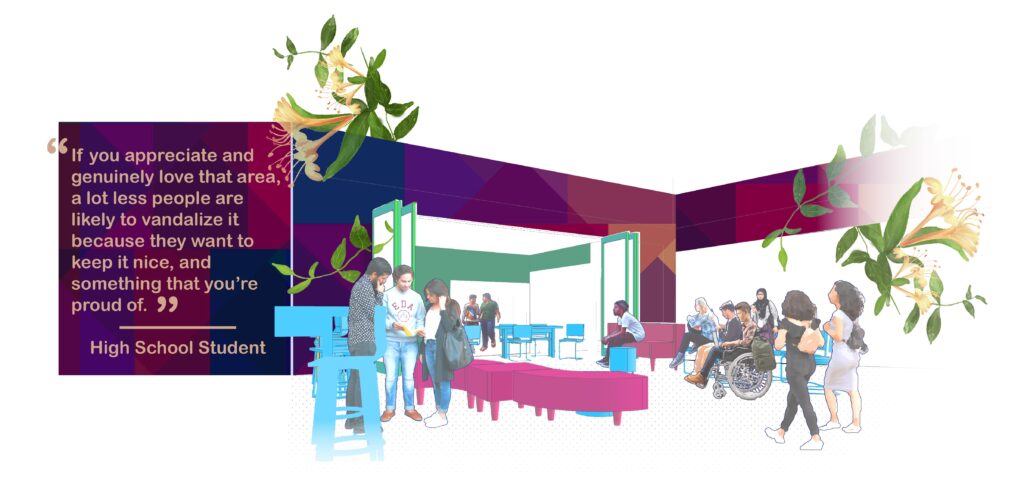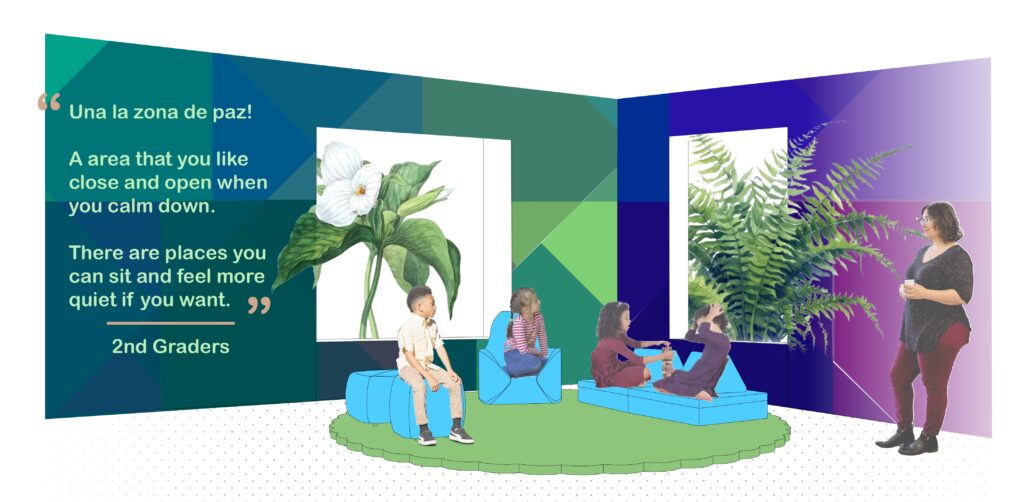As educators embrace restorative practices to reduce zero-tolerance policies and harmful student policing in schools, architects and designers must also align our design processes with restorative, relationship-centered methods that give diverse school communities the opportunity to define what safe space means to them.
Everyone arrives to school differently. Our unique identities and experiences shape every built environment we inhabit. They also inform how we each experience safety design solutions. For years, traditional approaches to safety design have prioritized crime prevention and disproportionately excluded, over-surveilled, and othered marginalized groups, specifically Black, brown, Indigenous and Asian communities, LGBTQIA+ communities, disabled communities, and houseless communities. In addition, frequent suspensions and expulsions have removed students from their classrooms and disconnected them from their school community; these exclusionary policies have resulted in excessive impacts on students of color and students with disabilities.
Our unique identities and experiences shape every built environment we inhabit.
Black and brown students specifically are disproportionately represented in school suspension rates across the US. A 2021 study of middle-school suspension rates in North Carolina showed students who attended schools with higher suspension rates had a higher chance of being arrested or incarcerated between the ages of 16 – 21.[1] To address the school-to-prison pipeline, educators have reformed their systems of behavioral support to be trauma-responsive and restorative. Restorative educational practices grow from long-held Indigenous peacemaking knowledge, which re-forms relationships between people and the world through solidarity and reciprocity, developing collaborative solutions to community and social problems.[2]
As restorative justice deconstructs and reshapes historically inequitable power dynamics in education, architecture too can acknowledge and repair harm in our design processes. School design approaches rooted in justice and equity position architects to not only design for physical safety, but to co-create communities of care alongside diverse school stakeholders that foster holistic wellness, inspire authentic self-expression, and empower students and educators to engage in restorative practices.
Beyond CPTED
Best practices for safe schools have evolved across different generations of CPTED (Crime Prevention through Environmental Design), which has long advocated that the design of physical environments can prevent crime through visibility, surveillance, and access control. More recently, these best practices have also emphasized design that supports social-emotional and mental health. While CPTED provides opportunities to guide our thinking, we need to acknowledge that it does not ensure safety for all, and that its emphasis on surveillance, exclusion, and control has historically harmed communities, especially over-policed Black and brown people. Ifeoma Ebo, an urban designer and architect, has described CPTED as having inequitable consequences when it supports aggressive over-policing in public spaces. She writes that, “The individual components are not problematic, but when they are combined and used in Black communities, CPTED becomes a weaponized extension of aggressive law enforcement.”[3]

CPTED is a prescriptive system of guidelines that has not historically centered equity in its practice. To cease the use of hostile and reactive safe design guidelines, the collective Design as Protest (DAP) advocates that we center community power over crime prevention.[4] Activated spaces of frequent community use and which reflect our unique cultural and social identities tend to be safer spaces. But safety is multi-faceted, and its design implications should be unique to each school community. With a need for equity-focused school safety programming, designers can support new visions for safer schools by aligning design processes to the same restorative and positive student support systems we hope to see educators engage in classrooms.
Active Listening & Learning
Active listening is one of the core tenets of restorative justice, which works to create more equitable and less punitive educational systems. To design safer schools, we need to adopt restorative practices which allow for those who have been most harmed by inequities to fully express their views on how to make things right.[5] In doing so, we can acknowledge the trauma and harm caused by both educational and architectural institutions and work to actively repair this harm.
Before we have program diagrams or site plans or roofs and walls, listening and learning sessions can be hosted by design facilitators to center the people in a school community who are most impacted by educational inequities. Working as active listeners, these sessions make space for us to better understand how the unique social identities of students and educators impact their experiences at school.
To design safer schools, we need to adopt restorative practices which allow for those who have been most harmed by inequities to fully express their views on how to make things right
In collaboration with trusted partner organizations and local leaders who have long-standing relationships within the community, we organize participatory groups from the ground up with shared common identities specific to each school. We ask who is most impacted in their community, how can we best hold space to hear their experiences, and what barriers can we lessen to increase their participation. This allows us to gather the stories and experiences that help us better define the design problems to solve.
This might look like an affinity space for Latina/o school families with a Spanish-speaking facilitator or joining the weekly Black Student Union gathering and collaborating with BSU leaders on discussion questions beforehand. We may also provide food, childcare, transportation assistance, or stipends to reduce barriers and create easier and more equitable access to participation. Sometimes communities are better served by virtual sessions or asynchronous opportunities to participate. In all, we trust the knowledge of community leaders and partners to help identify the who, how, and where.
Dialogues around school safety and belonging can also be difficult spaces for our communities to inhabit. They may bring up historical and racial trauma; they might trigger day to day anxieties or fears many of our students, staff, and families experience. We want to make sure that facilitators are trauma-informed practitioners, with resources to hold safe space and provide opportunities for aftercare when needed. As design facilitators, we can also make sure our methods of engagement are creating safe, culturally responsive, and gender-affirming spaces. For instance, we can prioritize asking student participants to provide their names and pronouns in listening spaces instead of relying on the names generated from student information systems, which may not accurately reflect students’ gender identities.

Identity-Safe School Design
Early listening and learning conversations provide time to understand the experiences and emotions embodied in community stories. They help to build long-lasting relationships between designers and the school community, ensuring that designing for safety and belonging is a collaborative process with frequent and reliable engagement that builds on community insights and worldviews. To create design processes that are culturally safe, designers can work to draw strengths from students’ unique identities and culture.
In recent conversations with elementary school students, we asked them when and where do you feel safe? Their school district had widely implemented positive behavioral supports such as quiet corners or zonas de paz in classrooms, as well as rest and return rooms within their counselling offices. Many students referenced these areas as their safest school spaces because they had control over the space, they could make a lot of their own choices, and because they had more one-on-one interactions with adults. They said they liked the dimmable lights and ambient sound choices, the soft and movable seating, and that they had options for different activities.
These spaces of refuge bring students and educators together to address the root causes of behavior issues and repair harm without further isolating students. They can also be spaces where educators have more opportunities to understand the varied cultural contexts and diverse experiences that impact how students behave and learn. In thinking about their future schools, many students said they wished they had more access to spaces that felt student-owned and helped them connect to adults, and that these kinds of space could either be embedded within their classrooms or closer to their classrooms and more frequent throughout the school.

Today, most of these spaces were not designed into the foundational fabric of the school but have been cultivated and curated by educators, made available in creative ways where space allows. They vary across schools and are reflective of the creativity of educators to meet unique student needs in their classrooms and support spaces.
Instead of pushing students out of the classroom, safe and inclusive design creates more opportunities for student behavioral and restorative support within the school community. Well-designed peace-building zones that allow students to move through a range of behaviors and emotions can cultivate more opportunities to reduce overall suspensions and minimize exclusionary practices.
Ultimately, we’re designing learning spaces for our school communities to feel safe and that they belong. Because our educational and architectural institutions have perpetuated inequity, we’re also designing processes to repair that harm. These processes must engage students, families, and educators as well as school resource staff, nurses, counselors, and administrators. Through reparative methods like active listening, relationship building, and culturally sustaining designs, we can disrupt historically inequitable practices and build trust within school communities such that students and educators are empowered to center their unique experiences, values, and needs in the design of safer schools.
Learn more on this topic by attending “Communities of Care: Reimagined Design Processes for Student Safety & Belonging” on Tuesday, November 7 at 8:00 am during EDspaces in Charlotte, NC.
[1] Conwright, A. (2022). Decarceration Begins with School Discipline Reform. Learning for Justice.
[2] Mirsky, L. (2004). Restorative Justice Practices of North American, First Nation and Other Indigenous People of North America: Part One. Restorative Practices. https://doi.org/https://www.iirp.edu/images/pdf/natjust1.pdf
[3] Krause, K. (2021, May 11). Whose Eyes on the Street? Landscape Architecture Magazine.
[4] (n.d.). Design Justice Demands. Design as Protest. https://www.dapcollective.com/demands
[5] Morgan, H. (2021). Restorative Justice and the School-to-Prison Pipeline: A Review of Existing Literature. Education Sciences. https://doi.org/https://files.eric.ed.gov/fulltext/EJ1293515.pdf

